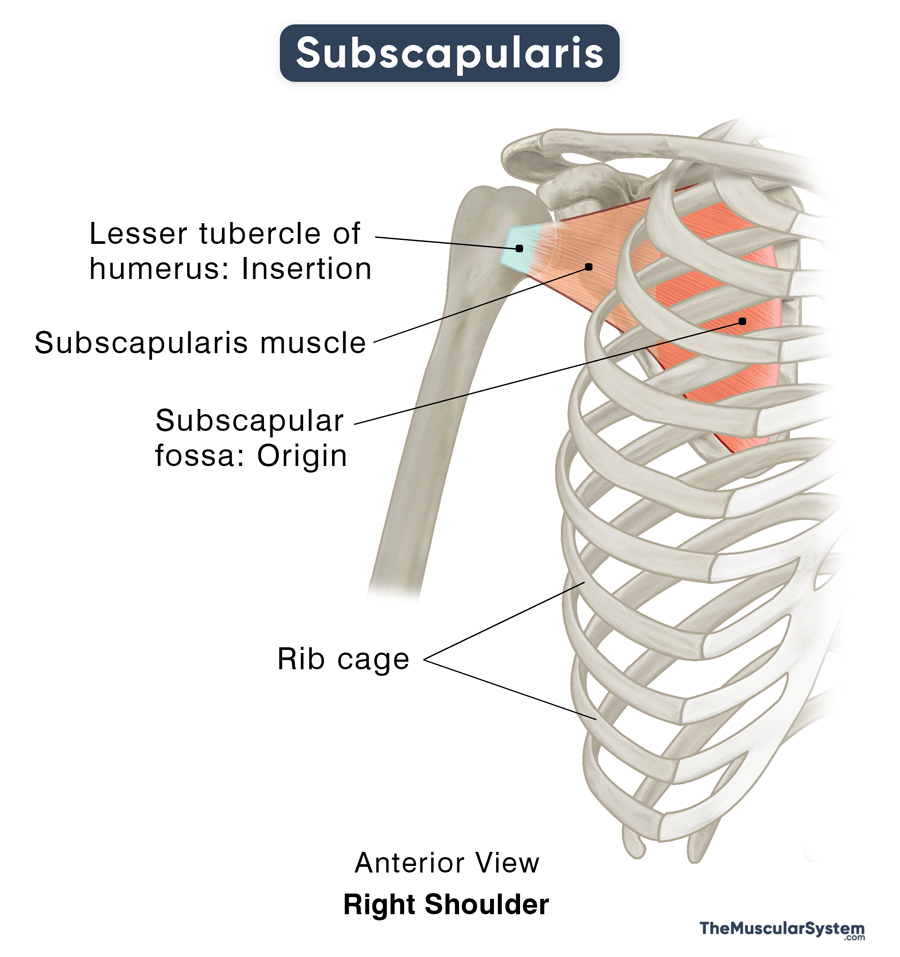Subscapularis
Last updated:
21/10/2024Della Barnes, an MS Anatomy graduate, blends medical research with accessible writing, simplifying complex anatomy for a better understanding and appreciation of human anatomy.
What is the Subscapularis
The subscapularis is a large, triangular shoulder muscle on the outer side of the upper back. The muscle gets its name from its location under the scapula, as ‘sub’ means ‘under’ and ‘scapularis’ refers to the scapula or shoulder blade.
It is one of the rotator cuff muscles making up the shoulder joint and helping it function. The other three are the teres minor, supraspinatus, and infraspinatus.
Anatomy
Location and Attachments
There are two subscapularis muscles in the shoulder, one on each side of the upper back.
| Origin | Subscapular fossa on the costal surface of the scapula |
| Insertion | Lesser tubercle of the humerus |
The large muscle fills the concave area called the subscapular fossa at the front surface of the scapula. Its origin covers the medial part of the fossa and the lower two-thirds of the scapula’s axillary or lateral border.
The muscle fibers then run laterally, gradually narrowing down into a tendon to attach to the humerus. Here, the tendon is separated from the neck of the scapula by the subscapular bursa, a large bursa at the shoulder joint.
Relations to Other Muscular Structures
The superior-outer part of the subscapularis is covered by the thoracic wall muscle serratus anterior. The biceps brachii and coracobrachialis cover the inferior-medial aspect.
Loose connective tissues occupy the fascial (open) spaces between the subscapularis and serratus anterior, and the rib cage. These tissues are crucial in the gliding movements of the joint between the scapula and rib cage (scapulothoracic joint).
The subscapularis muscle tendon runs continuously with that of the teres major, both participating in similar actions and sharing the same nerve supply. The tendon is also continuous with the long head of the triceps brachii, as well as the other three rotator cuff muscles, teres minor, supraspinatus, and infraspinatus. Together, these tendons form the rotator cuff capsule around the glenohumeral joint.
The subscapularis, along with the teres major and latissimus, forms the posterior axillary wall. It also joins the teres major and minor, the glenohumeral joint capsule, and the humerus in forming the three axillary spaces: the upper and lower triangular spaces and the quadrangular space.
The brachial plexus, and its branches, the axillary nerve, artery, and vein, run over the middle part of the subscapularis.
Functions
| Action | Medial rotation of the arm at the shoulder joint |
- It is the only rotator cuff muscle to help with medial or inward rotation of the arm. This movement happens as a result of the contraction of the muscle. One example would be when you slam the door behind you.
- The muscle can help with adduction and extension of the arm in certain positions.
- It prevents the humerus from displacing anteriorly, thus stabilizing the shoulder joint.
The infraspinatus and teres minor muscles act as antagonists to the subscapularis.
Innervation
| Nerve | Upper and lower branches of the subscapular nerves (nerve roots C5, C6) |
The upper branch of the subscapular nerve originates from the upper brachial cord, innervating the upper half of the muscles.
On the other hand, the lower branch stems from the posterior cords of the brachial plexus, further dividing into two branches, the lower and upper. The upper one innervates the muscle’s lower half.
Blood Supply
| Artery | Suprascapular (axillary branch), axillary (subclavian artery extension), and subscapular arteries (subclavian artery branch) |
References
- Subscapularis Muscle – Attachments, Action & Innervation: GetBodySmart.com
- Subscapularis Muscle: KenHub.com
- Anatomy, Shoulder and Upper Limb, Subscapularis Muscle: NCBI.NLM.NIH.gov
- Subscapularis: Rad.Washington.edu
- Subscapularis Muscle: Action, Origin & Insertion: Study.com
- Subscapularis: HealthLine.com
- Subscapularis Muscle: RadioPaedia.org
- Subscapularis Muscle: IMAIOS.com
Della Barnes, an MS Anatomy graduate, blends medical research with accessible writing, simplifying complex anatomy for a better understanding and appreciation of human anatomy.
- Latest Posts by Della Barnes, MS Anatomy
-
Dorsal Interossei of the Foot
- -
Flexor Digiti Minimi Brevis of the Foot
- -
Adductor Hallucis
- All Posts






